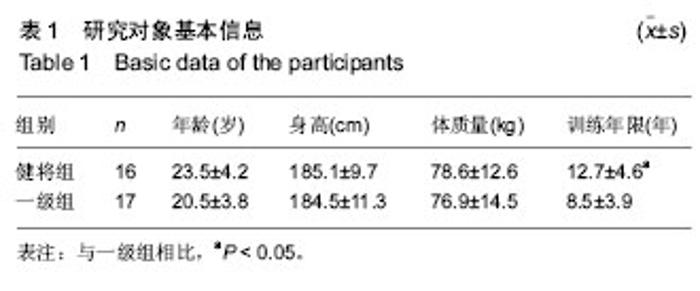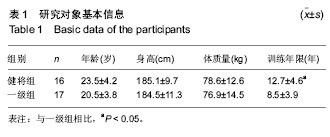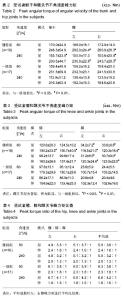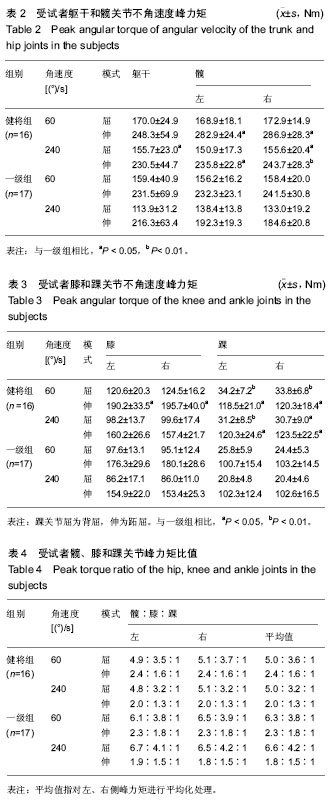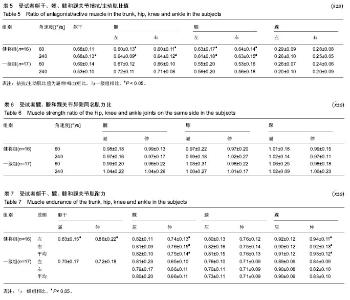| [1] 吴新华,蒋云飞,程亮,等.优秀男子跳远运动员下肢关节等速肌力特征的分析[J].成都体育学院学报,2013,39(10):86-89.[2] 熊维志.优秀男子举重运动员腰背、膝关节等速肌力与专项成绩的相关性研究[J].成都体育学院学报,2014,40(5):57-62.[3] Signorile JF, Sandler DJ, Smith WN, et al. Correlation analyses and regression modeling between isokinetic testing and on-court performance in competitive adolescent tennis players. J Strength Cond Res. 2005; 19(3):519-526.[4] 鞠秀奎.青少年男子体操运动员主要关节的等速肌力特征[J].中国组织工程研究, 2016,20(46):6922-6929.[5] 宋爱晶,邓京捷,吕晓红,等.等速肌力测试膝、踝关节及腰背肌力量的评价[J].中国组织工程研究,2015,19(46):7425-7429.[6] 马涛,高炳宏.青少年运动员肩关节屈伸肌等速肌力测试与分析[J].中国组织工程研究,2016,20(24):3595-3601.[7] 杨学达,李晓兰.跨关节肌肉力量与人健身关节操的影响[J].中国组织工程研究, 2015,19(15):2366-2370.[8] 葛卫忠.青少年男子篮球运动员膝关节等速肌力特征研究[J].山东体育学院学报, 2010,26(3):46-50.[9] 罗兴来,刘雪峰,程亮,等.四川省少年男篮运动员膝关节等速肌力特征分析[J]. 四川体育科学,2016,35(3):36-39.[10] 肖冰,叶展红,庞杰.优秀青少年男子篮球运动员腰腹屈伸肌群生物力学特征[J]. 中国组织工程研究,2015,19(24):3889-3893.[11] 林长地,程亮.少年男篮运动员下肢等速肌力与纵跳高度、速度的相关性分析[J].山东体育科技,2015,37(4):72-76.[12] Carvalho HM, Mj CES, Ronque ER, et al. Assessment of reliability in isokinetic testing among adolescent basketball players. Medicina.2011; 47(8):446-452.[13] Bradic A, Bradic J, Pasalic E, et al. Isokinetic leg strength profile of elite male basketball players. J Strength Cond Res. 2009; 23(4):1332-1337.[14] 罗安民,李珺晖,洪平.综合力量训练对中国女子篮球运动员腰、膝、踝等速力量的影响[J].中国体育科技,2012,48(2):35-39.[15] Rouis M, Coudrat L, Jaafar H, et al. Assessment of isokinetic knee strength in elite young female basketball players: correlation with vertical jump. J Sports Med Phys Fitness. 2015;55(12):1502.[16] Brown SR, Brughelli M, Bridgeman LA. Profiling Isokinetic Strength by Leg Preference and Position in Rugby Union Athletes. Int J Sports Physiol Perform. 2016; 37(11):890-897.[17] 余利容,张乾伟.优秀男子举重运动员专项成绩与下肢等速肌力相关回归分析[J].武汉体育学院学报, 2017,51(6):89-94.[18] Andrade MS, De Lira CA, Koffes FC, et al. Isokinetic hamstrings-to-quadriceps peak torque ratio: the influence of sport modality, gender, and angular velocity. J Sports Sci. 2012; 30(6):547-553.[19] 辜伟,程亮.优秀女子武术运动员膝关节等速力量测试研究[J].成都体育学院学报,2013,39(4):77-80. [20] 卢澎涛.优秀男子游泳运动员肩关节等速肌力特征分析[J].成都体育学院学报,2014,40(12):58-62.[21] 罗安民,李珺晖,洪平.中国女子篮球运动员膝关节等速肌力测试分析[J].中国运动医学杂志,2012, 31(6):517-522.[22] 吴毅,占飞.等速肌力测试和训练技术在运动医学中的应用[J].中国运动医学杂志,2002,21(1):81-84.[23] 陈星强,程亮,常书婉.四川省优秀自由式摔跤运动员膝关节等速力量测试的分析[J].四川体育科学, 2012,5:32-35.[24] 林长地,程亮,林晞.全身振动训练对老年女性平衡能力和下肢关节肌力的影响[J].首都体育学院学报, 2015,27(6):572-576.[25] 巴洪冰,程亮.高频全身振动训练及停练后对老年女性骨密度的影响[J].中国骨质疏松杂志,2017, 23(4):428-430.[26] Lee JH, Hoshino Y, Nakamura K, et al. Trunk muscle weakness as a risk factor for low back pain. A 5-year prospective study. Spine.1999;24(1):54-57.[27] Sonza A, Andrade M C. Analysis of the isokinetic torque curves in shoulder movements. Rev Bras Med Esporte. 2012;18(2):91-94.[28] Tanaka D, Suga T, Tanaka T, et al. Ischemic preconditioning enhances muscle endurance during sustained lsometric exercise. Int J Sports Med. 2016;37(8):614-618.[29] 郑丽,孟国正.力量训练中面对的三个问题:方法、内容与周期[J].武汉体育学院学报,2017, 51(1):88-91.[30] 卓金源,吴赵昭,徐旻霄,等.高原体能训练对我国高水平优秀篮球运动员身体机能与形态的影响研究[J].北京体育大学学报,2017, 40(3):93-100. |
